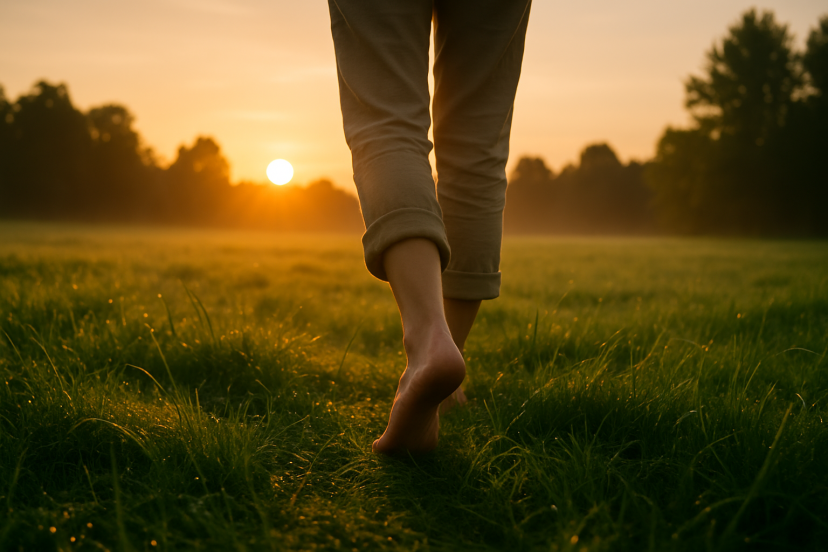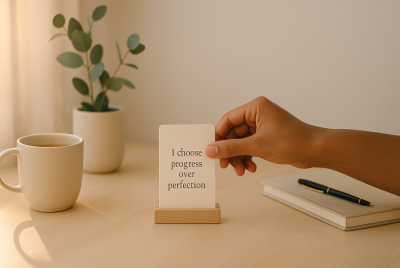Nature-Based Grounding Practices To Try This Summer
We may earn a commission for purchases made using our links. Please see our disclosure to learn more.
Have you ever felt like your mind is racing faster than your body can keep up? Maybe you’ve had one of those days where stress just clings to you, even when you’re supposed to be relaxing. I get it—I’ve been there too. That’s where grounding practices come in. These simple, nature-based rituals help you reconnect with the earth, calm your nervous system, and find peace in the present moment.
In this guide, I’ll share practical grounding techniques you can try this summer, mix in a few personal reflections, and even recommend some Amazon finds to make your journey smoother. By the end, you’ll have a toolkit of grounding practices to use anytime you need to reset your mind and body.
Why Grounding Matters
Grounding isn’t just a trendy buzzword—it’s about realignment. Think of it as plugging yourself back into nature’s outlet when your energy feels drained.
Benefits of grounding practices:
- Reduce anxiety and stress
- Improve sleep quality
- Boost mental clarity
- Encourage emotional balance
When life feels chaotic, grounding is a gentle reminder: you belong here, now.
Barefoot Walking (Earthing)
Walking barefoot on the earth—often called earthing—is one of the most accessible grounding practices. When your feet touch soil, grass, or sand, you’re not just enjoying texture—you’re reconnecting with the planet’s subtle electrical currents.
Why it matters: Many cultures have long recognized the healing power of walking barefoot. In Ayurveda, it’s seen as a way to balance your energy, while Indigenous traditions often include direct connection with the land as a form of spiritual respect.
How to do it:
- Start with 5–10 minutes in your backyard or at a park.
- Walk slowly, letting your attention focus on each step.
- Notice textures: the coolness of dew on morning grass, the warmth of sand in the afternoon, the firmness of soil after rain.
Personal tip: I started doing this during my morning coffee ritual. Mug in hand, bare feet on the grass—it’s amazing how quickly my stress softens.
Morning Grounding Ritual at Sunrise
There’s something incredibly calming about being awake while the world is just beginning to stir. A sunrise ritual grounds you before the chaos of the day even begins.
Try this flow:
- Stand barefoot on grass or sand.
- Stretch your arms overhead, as if greeting the sun.
- Take five deep breaths, inhaling new energy, exhaling yesterday’s worries.
- Set an intention for the day: “Today, I’ll move with calm,” or “Today, I’ll be present.”
Analogy: Think of this ritual like downloading the day’s software update—before your mind starts running, you’re programming it with clarity and calm.
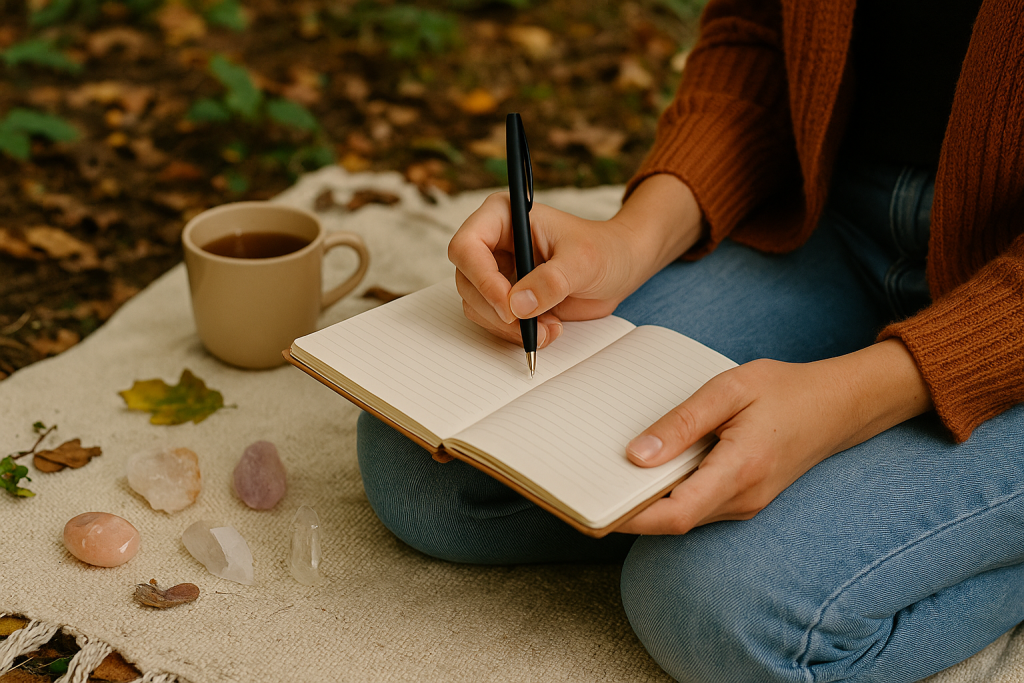
Gardening As Meditation
Gardening is often underestimated as a grounding practice, but it’s more than just planting seeds—it’s partnering with nature.
Benefits you’ll notice:
- The repetitive movements (digging, planting, watering) create a meditative rhythm.
- Touching soil can boost mood thanks to mycobacterium vaccae, a natural microbe found in dirt linked to serotonin production.
- Watching a seed sprout into something alive is a powerful reminder of patience and growth.
No garden? No problem: Container gardening on a balcony or even a few herbs on a windowsill can still anchor you to nature.
Reflective question: What’s one small plant you could care for that might mirror the growth you want to see in yourself this season?
Forest Bathing (Shinrin-Yoku)
Forest bathing, or Shinrin-Yoku, comes from Japan, and it’s about immersing yourself in the forest atmosphere. It’s not exercise—it’s presence.
How to practice:
- Stroll gently, allowing the path to guide you rather than a set goal.
- Observe how sunlight filters between the leaves.
- Smell the earthy scents of moss and pine.
- Pause often—touch tree bark, listen to birds.
Science connection: Studies show that spending time in forests lowers cortisol levels, blood pressure, and even boosts immune function. It’s your body’s way of saying, “Thank you for slowing down.”
Ocean Connection
The ocean is one of the most powerful grounding forces. Standing where water meets land creates a sense of surrender—you feel both small and infinite.
Grounding rituals at the shore:
- Toe dip therapy: Stand ankle-deep in the surf and breathe with the rhythm of the waves.
- Sand anchoring: Bury your feet slightly in the wet sand and imagine roots growing into the earth.
- Ocean journaling: Bring a small notebook and write down what you’re letting go of with each receding wave.
Personal story: I once spent a summer evening just watching waves roll in. By the time the sun set, the heaviness I’d carried all week had melted away. That’s the ocean’s quiet medicine.
Rock & Crystal Meditation
Holding a stone in your palm, feeling its texture, and focusing on its weight brings you back to the present.
- Choose grounding stones like hematite, obsidian, or smoky quartz.
- Sit comfortably, close your eyes, and hold the stone as you breathe deeply.
- Visualize your energy flowing into the stone and returning back steadier, calmer.
Journaling Outdoors
Bring a notebook to the park, jot down thoughts, and let nature guide your reflection.
- Write what you’re grateful for.
- Note how the breeze feels, what you hear, and how your body responds.
- Use journaling prompts like: “What do I need to release right now?”
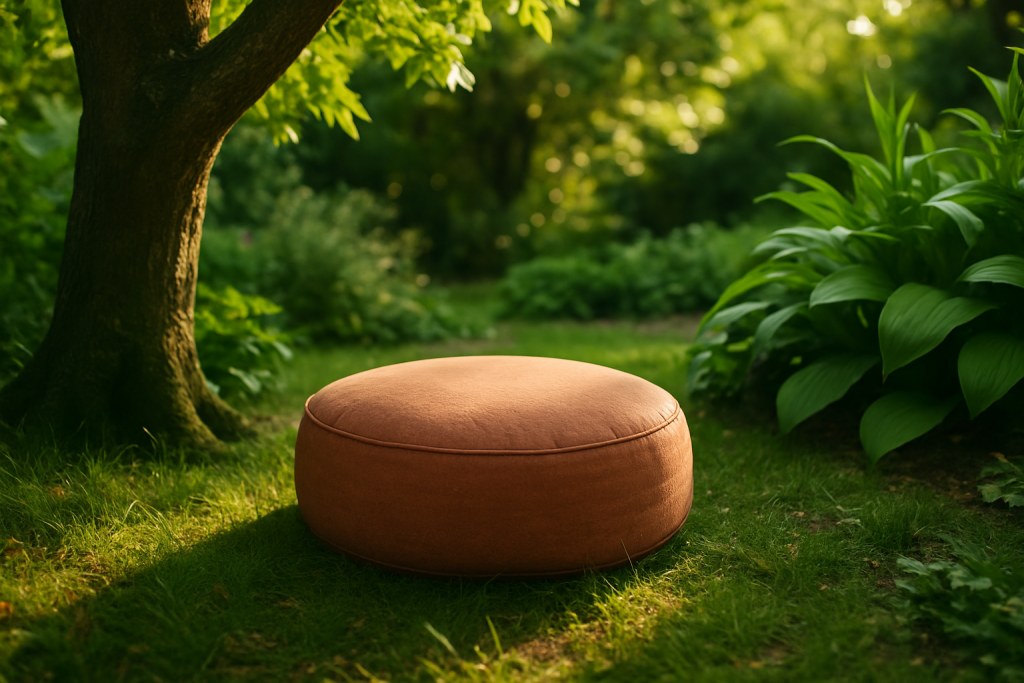
Stargazing at Night
If sunrise grounds you with beginnings, stargazing grounds you with perspective. Looking up reminds us how vast the universe is and how small our problems can feel in comparison.
How to enhance it:
- Bring a cozy blanket and lay flat on the ground.
- Use a stargazing app to learn constellations, or simply let your imagination wander.
- Pair it with deep breathing: inhale under the stars, exhale into the universe.
Cultural perspective: Ancient civilizations used stars not only for navigation but also for spiritual connection. For example, Native American traditions often saw constellations as guides for storytelling and wisdom.
Breathwork with Nature Sounds
Sit under a tree, close your eyes, and sync your breath with the sounds of rustling leaves or chirping birds.
- Inhale gently for four counts, hold it for four, exhale over four, and wait another four before starting again.
- Let nature become your metronome.
Grounding Practices for Stressful Days
When anxiety spikes, step outside, place your hands on the bark of a tree, and let yourself imagine releasing stress into its roots.
It sounds simple, but symbolic gestures often unlock deeper calm than logic ever could.
Mindful Eating Outdoors
Try eating fresh fruit outside—slowly, with attention to texture, flavor, and smell. A peach dripping with juice under the summer sun is grounding in a way no rushed meal at your desk ever could be.
Cooling Water Ritual
Summer heat can make us restless, and water provides an instant grounding reset.
Ideas to try:
- Dip your feet in a stream or river.
- At home, fill a basin with cool water, add a few drops of lavender oil, and soak your feet for 10 minutes.
- Swim mindfully—pay attention to how your body floats, moves, and rests in water.
Analogy: It’s like turning down the thermostat on your nervous system.
Walking Meditation
This technique blends gentle motion with present awareness.
- Take slow, deliberate steps.
- With each step, silently say: “I am here.”
- Notice your heel, arch, and toes connecting to the ground.
It’s grounding through motion, perfect for restless minds.
Campfire Reflection
If you’re camping this summer, sit quietly by the fire, noticing the crackles and warmth. Fires have always been communal and spiritual—let this one remind you of ancient grounding traditions shared around flames.
Amazon Picks to Support Your Grounding Practices
Here are some practical tools to deepen your rituals. Each one ties beautifully into the grounding practices we’ve covered:
1. Hooga Grounding Mat for Sleep, Energy, Pain Relief, Inflammation, Balance, Wellness
- Why you’ll love it: A simple way to stay grounded indoors when you can’t be outside barefoot. Perfect for working at your desk or placing beside your bed.
- Pros: Conductive carbon surface, slip-resistant, easy to clean, and comes with a 15-foot cord for flexible placement.
- Cons: Requires a properly grounded outlet; effects may be subtle and build over time.
- Best use case: Keep it under your desk during the workday or next to your bed at night for ongoing connection.
2. Zenexcel Grounding Mat for Feet w/ 15ft Grounding Cord – 24″x16″ Premium Conductive Carbon Earthing Pad
- Why you’ll love it: Compact and portable, this mat is perfect if you want grounding while journaling, meditating, or working from home.
- Pros: Waterproof, anti-slip PU leather with premium carbon, easy to clean, generous 15-foot grounding cord.
- Cons: Covers a smaller area than bed-sized mats.
- Best use case: Slip it under your feet during your morning ritual or place it at the foot of your meditation cushion.
3. Zenexcel Grounding Mat for Bed – 34″x24″ Premium Conductive Carbon Earthing Pad w/ 15ft Grounding Cord
- Why you’ll love it: Larger than the foot mat, this one is designed to cover more skin area—great for bedtime grounding.
- Pros: Premium conductive carbon and waterproof PU leather, anti-slip, and long cord for flexibility.
- Cons: Less portable; best suited for at-home use.
- Best use case: Lay on it before sleep to wind down, or use it as part of your nighttime reading and relaxation ritual.
4. Vivere Double Cotton Hammock with Space-Saving Steel Stand, Upgraded Polyester End Strings 450 lb Capacity – Tropical
- Why you’ll love it: A grounding practice doesn’t have to be serious—it can be as joyful as lounging in a hammock under the trees.
- Pros: 100% cotton bed, breathable and soft, steel stand included so you don’t need trees, supports up to 450 lbs, comes with a carry bag.
- Cons: Cotton fabric requires care to avoid mildew; stand can rust if left exposed to rain.
- Best use case: Perfect for backyard grounding, reading in the shade, or stargazing on summer nights.
5. Dynta Waterproof Pocket Notebook 3×5, 6-Pack (All-Weather)
- Why you’ll love it: Journaling outdoors is one of the most grounding practices, but notebooks often get ruined by dew, sand, or rain. These waterproof notebooks let you reflect anywhere without worry.
- Pros: Waterproof stone paper pages, flip-spiral design, durable covers, and comes in a 6-pack so you can stash them in your bag, car, or desk.
- Cons: Smaller page size; stone paper may not work well with every type of pen.
- Best use case: Great for writing gratitude notes during forest bathing, reflections at the beach, or jotting thoughts during sunrise meditation.
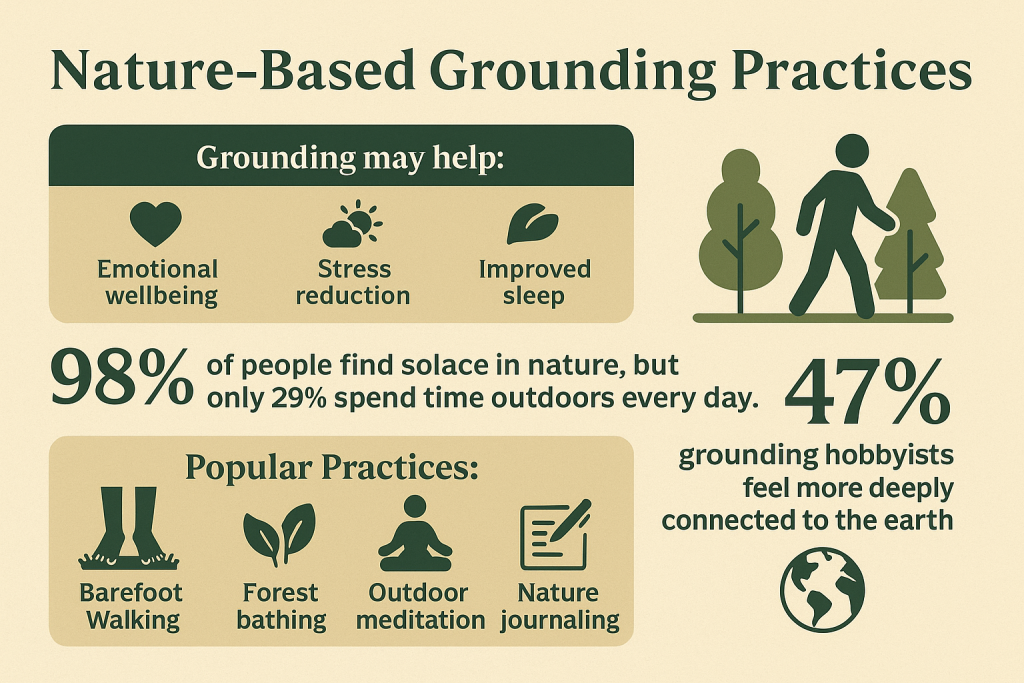
Comparison Table
| Product | Best For | Pros | Cons |
| Hooga Grounding Mat | Indoor grounding (desk, bedside) | Conductive carbon, slip-resistant, long cord | Needs grounded outlet |
| Zenexcel 24″x16″ Mat | Feet/journaling/meditation | Compact, waterproof, portable | Smaller coverage |
| Zenexcel 34″x24″ Bed Mat | Nighttime rituals & sleep | Large surface, flexible use | Less portable |
| Vivere Cotton Hammock + Stand | Backyard relaxation, stargazing | Soft cotton, steel stand, carry bag | Needs care to avoid mildew |
| Vivere Sunbrella Hammock + Stand | Outdoor durability & weather resistance | Fade-resistant, heavy-duty fabric | Pricier & heavier |
🧪 Research-Backed Benefits of Grounding
Science backs up what ancient cultures already knew: grounding works.
- A study in the Journal of Environmental and Public Health found that grounding can reduce inflammation and improve mood (read the study on grounding and health).
- Research from Frontiers in Psychology highlights how spending time in nature lowers cortisol and stress levels (explore the study on nature and stress reduction).
FAQs
How do grounding practices work?
Grounding practices are activities that reconnect your body and mind to the natural world, reducing stress and improving balance.
Can grounding practices improve sleep?
Yes—many people report deeper, more restful sleep after regular grounding rituals.
How often should I practice grounding?
Even 10–20 minutes daily can make a noticeable difference.
Are grounding mats as effective as walking barefoot?
They’re a great alternative for indoors, but nothing beats direct earth contact.
Can kids benefit from grounding practices?
Absolutely! Outdoor play, barefoot walks, and gardening can be grounding for children too.
Helpful Resource
If you want to go deeper into spiritual alignment alongside grounding, check out this guide on astrology readings for personal development.
Conclusion
Grounding practices aren’t about perfection—they’re about presence. This summer, let nature be your reset button. Whether it’s barefoot walking, journaling outdoors, or stargazing, these rituals can bring peace and clarity into your daily life. Start small, stay consistent, and let the earth remind you of the calm that’s always available.

